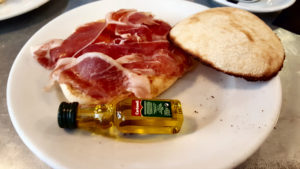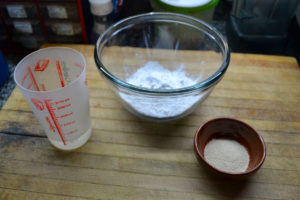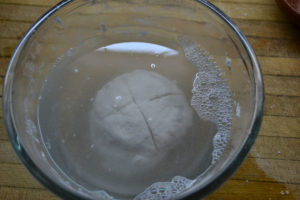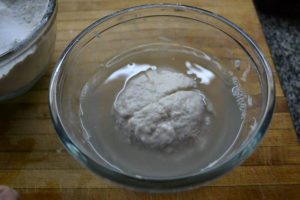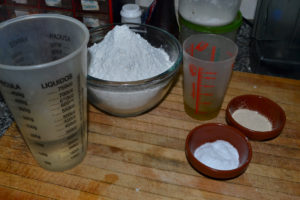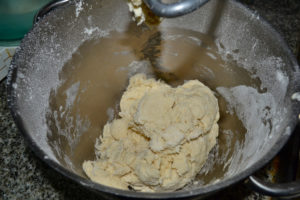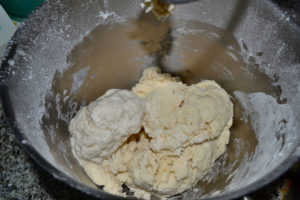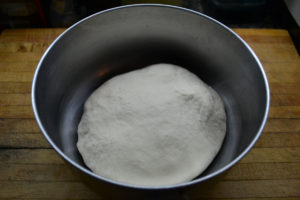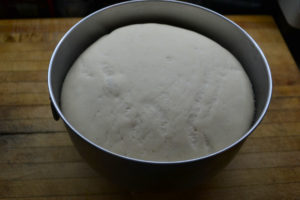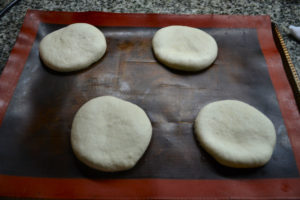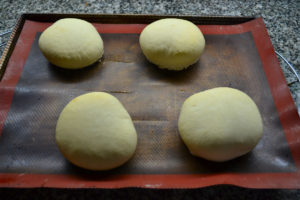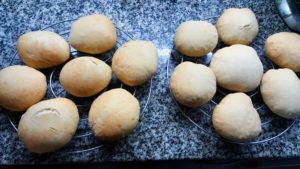There are, as best I can tell (with regional variations), quite a few kinds of molletes. The literal translation of the word is muffin, and various Spanish language sites suggest using it to ask for one with your morning coffee, though I’ve not encountered it used that way. In the various countries I’ve been in, what I think of as a muffin is more often referred to as some sort of budín, pastelito, tortita, bollo, or bisquét. You may remember I mentioned my favorite breakfast in Madrid – grated tomatoes, olive oil, and cured Ibérico ham on a toasted mollete, clearly a sandwich bread….
Back to the various types of molletes: In Spain, it’s a round, somewhat flattened bread roll with a soft crust, generally used for sandwiches; In Mexico, it’s a buttered short baguette topped with refried beans, cheese, and pico de gallo; In Bolivia, it’s a very rich, sweetened whole wheat egg bread with a cheese covered crust; In Cuba, they take round bread rolls, remove some of the dough from the center, moisten it with wine and sugar, and then fill it with a stuffing made from ground meat, the bread dough that was pulled out of the rolls, wine, garlic, onions, tomato puree, herbs and spices; In Guatemala, they’re a special food for El Día de los Muertos, and are basically a custard filled French toast; And, in the Honduras, they do take a muffin shape, but made from bits of dinner roll dough mixed with various other things and sort of molded into a ball before baking – pizza flavor seems to be popular, with cheese, oregano, and pepperoni, though I can’t imagine that’s overly traditional.
So, my goal? I’m going to explore them all, one by one. Let’s start with Spain!
First off, we make a masa madre, a mother dough – basically something to get the fermentation of the yeast really going. 100 grams of good bread flour, 5 grams of instant yeast (1/2 a packet), and 50 ml of warm water. Mix together in a bowl to make a soft ball – you don’t have to knead this until smooth or anything, you just want to combine it well.
Here it gets interesting, I’ve never encountered a bread made this way. Take the ball of dough, cut an X in it (or a few cuts, doesn’t matter), and stick it in a bowl of warm water. It’ll sink, but almost immediately, you’ll see it start to form little bubbles from the yeast fermenting.
It all happens very fast – in under ten minutes, it’ll be bubbling merrily away, and the ball will float to the surface. When it does, you’re ready for step two – so be prepared…. In fact, having now done this a few times (we really like the bread), I start the next step mixing pretty much right after putting the madre in the water.
500 grams bread flour, 330-350 ml warm water (it will vary with the type of flour you use, the humidity, etc., start by adding about 300 ml, and then add more as needed), 50 ml good olive oil, 5 gm instant yeast (the other half of the packet), 20 gm salt (it seems like a lot, but it works).
Mix well to get a semi-soft dough. Remember you’re going to be adding the sopping wet masa madre, so don’t go too soft at this point, wait on adding that extra water. You also don’t need to knead it at this point, just combine well.
Put the masa madre into the mixture (not the water it was sitting in, you can toss that). Now you combine it well and let it knead until very smooth. If it isn’t soft and smooth and elastic, here’s where you add the remaining water a little at a time until it is.
Put the dough in a bowl that’s lightly oiled with olive oil. Cover with a cloth, and let rise in a warm place until doubled in size.
And, here it is, about 35-40 minutes later.
If you’re making sandwich rolls of the classic size, this huge ball of dough gets divided into just eight equal portions, roll each into a ball, then flatten on a non-stick baking sheet. Cover and let rise, but not too much – they will puff up a lot when put in the oven, so the recommendations I got were to just let them sort of puff into a squat flying saucer shape. Have the oven preheated basically to maximum if it’s a home oven – 275°C/525°F. Put a shallow pan of hot water in the bottom of the oven when you start heating it, to help fill it with steam.
Put in the oven, and immediately reduce the heat to 200°C/400°F. Bake until puffed, and just slightly golden – you don’t want to form a hard crust on these, they should stay soft and not be overly browned. For the big ones it takes about 20 minutes. We also tried them just as bread rolls, rather than sandwich rolls, and made them half sized, and those only took about 15 minutes and were already darker than the bigger ones.
Delicious!
Voilá! Spanish molletes. Stay tuned for more….
